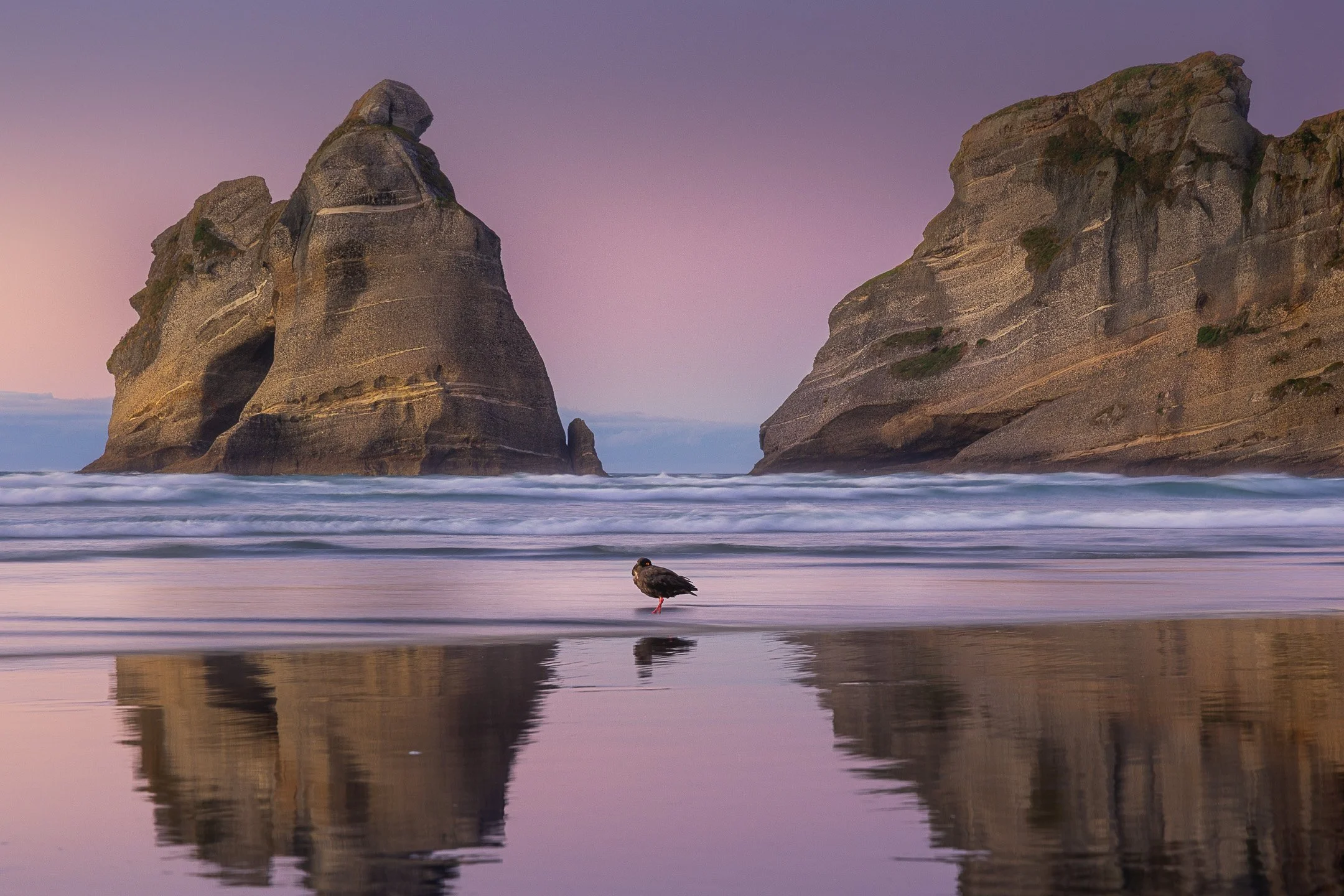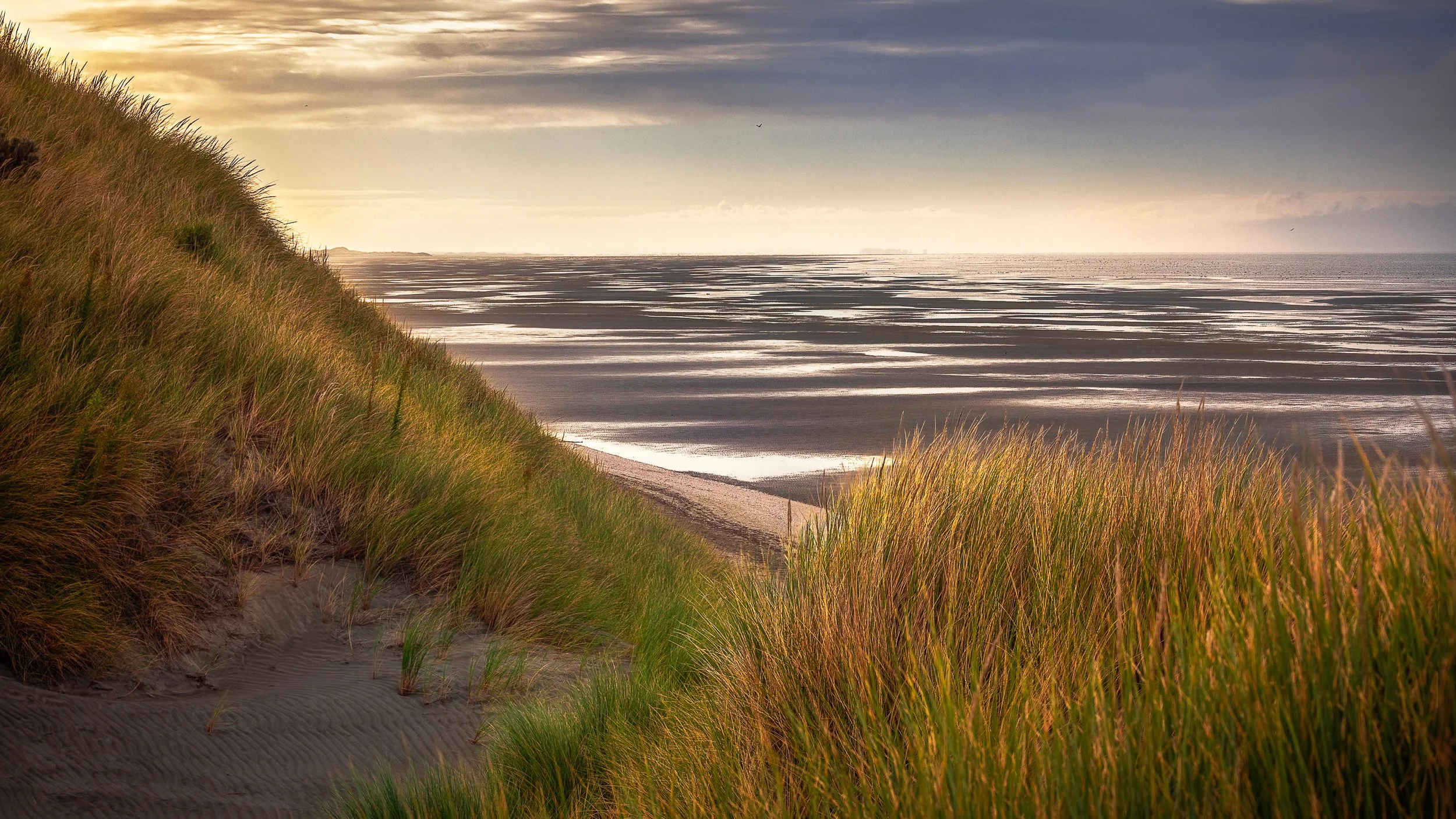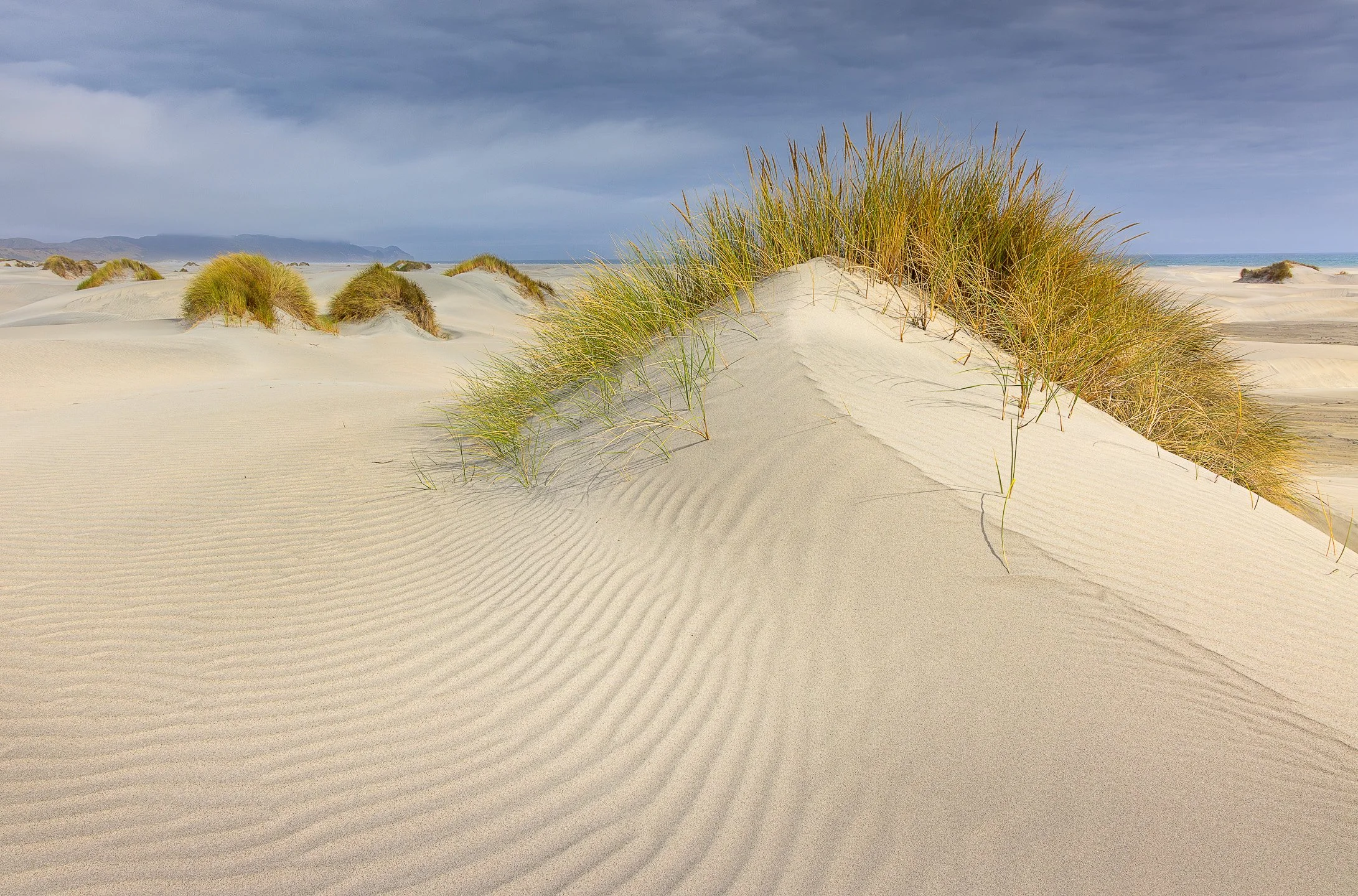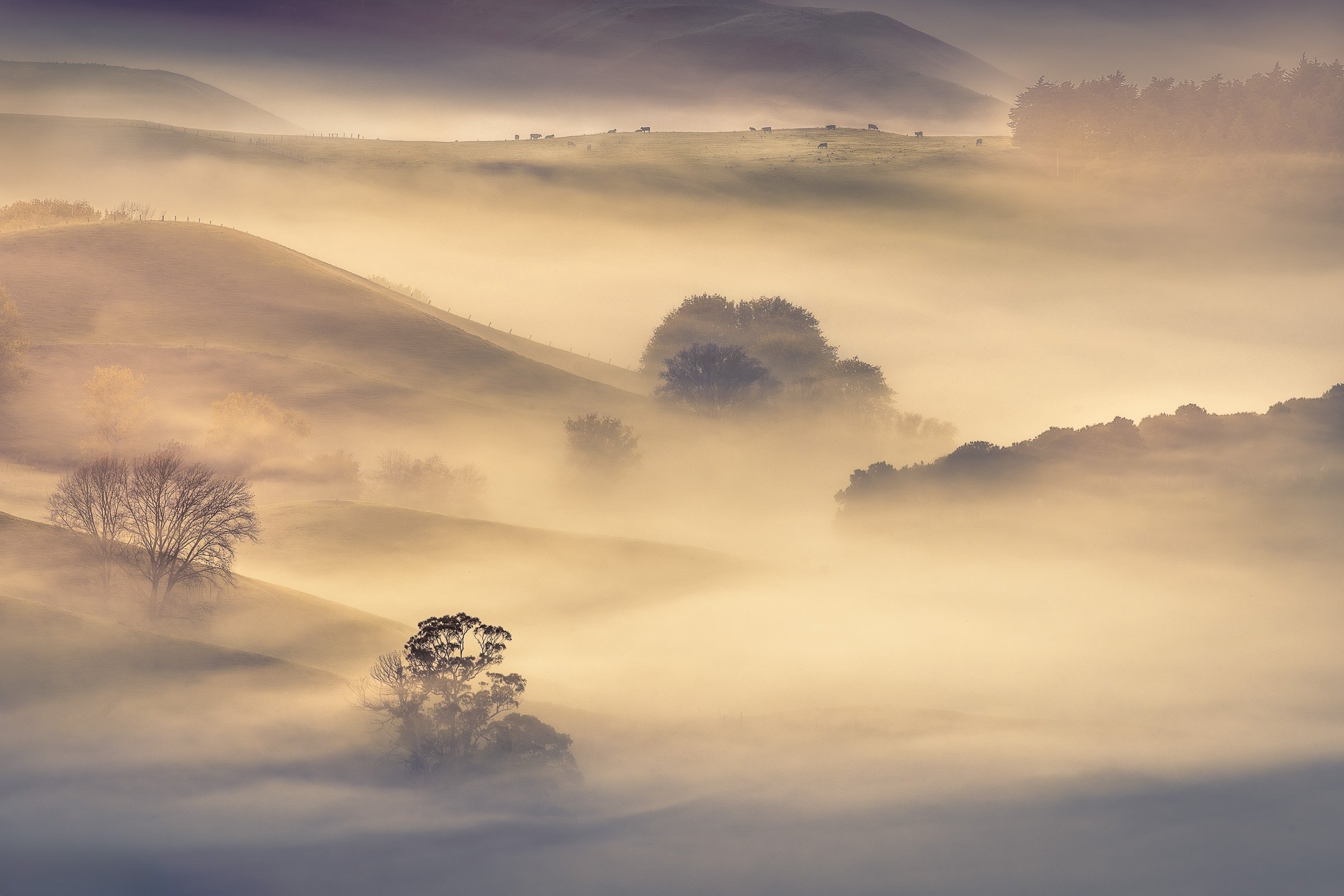Exploring Cape Farewell
Hiking and photographing one of New Zealand’s most dramatic coastal landscapes.
In March this year we set off in our motorhome to explore a corner of Golden Bay in the Tasman Region that we had never visited before: Cape Farewell. Marking the northernmost point of the South Island, this windswept headland is where sheer cliffs plunge dramatically into the Tasman Sea. Despite its name, the cape felt less like a place of parting and more like an invitation—to witness light, atmosphere, and sea in constant motion.
We based ourselves at a campsite, a 15-20-minute walk to the famous Wharariki Beach.
Sunrise and Sunset at Wharariki Beach
Wharariki Beach, with its iconic Archway Islands, tidal pools, and shifting dunes, is a photographer’s dream, especially in the low light of dawn and dusk when long shadows and soft hues transform the landscape. The whole area feels remote and untamed, where weather and light can change in an instant, rewarding those willing to wait and watch.
Over the few days that we were staying here, I visited the beach several times, at sunset, sunrise, and during the day. The coastal weather was very variable, so I got all sorts of shots while trying to protect myself and my gear from wind and showers.
Layers of Wharariki Beach
In soft golden light, Wharariki Beach reveals its layers—the rippled dunes in the foreground, the sweeping sands beyond, the distant Archway Islands, and finally the sky unfolding above.
In between Storms
Low tide reveals a sculpted world at Wharariki Beach — rock pools like glass, drift patterns in the sand - enhanced by storm clouds gathering over the horizon.
One sunrise shoot in particular stands out. I had set up well before dawn, knowing the sun would rise behind me and hoping it would illuminate the Archway Islands ahead. As I waited, a heavy raincloud swept in from the Tasman, threatening to smother any chance of colour. But just as the sun crested the horizon, it broke through, casting light across the sea stacks. And then, for the briefest moment, a rainbow arced above the islands—a soft, perfect curve against the shifting sky. Moments later the light was gone, the rain closed in, and everything turned grey. Yet for those few seconds, everything came together.
Rainbow at the Archway Islands
Sunrise at Wharariki Beach — one of those wild, unpredictable moments that make landscape photography so rewarding.
Between the Archways
An oystercatcher stands at the water’s edge, framed by the towering Archway Islands and reflected in the pastel-glazed sand. The surf murmurs in the hush of twilight, as fading light softens the rugged coastline into a moment of stillness. Captured at Wharariki Beach, this fleeting balance of motion and calm was offering a rare moment of quiet presence by the sea.
Hiking the Puponga Hilltop Walk
The Hilltop Walk at Cape Farewell may be short (about 5.5km), but it feels like a journey along the very edge of the South Island. The track follows rolling farmland ridges, where green hills suddenly give way to sheer sandstone cliffs plunging into the Tasman Sea. To the northeast, Farewell Spit stretches like a golden ribbon into the horizon; to the southwest, Wharariki Beach and the Archway Islands stand against the surf.
You’re quite exposed to the elements while walking on top of the steep cliffs and I was glad we had brought our rain jackets. It was a walk where the weather changed every few minutes.
Passing Storm
The view towards Pillar Point while a storm is moving through. The cliffs drop steeply into the sea, and the sky felt heavy and threatening. Then, for just a moment, the clouds shifted and a shaft of light broke through, painting the rolling hills in front of me with a soft glow. It was one of those fleeting, magical contrasts between storm and calm that make you pause and simply take it all in.
The walk is filled with sweeping coastal views, but the real climax comes near Pillar Point, where the panorama opens towards the dunes of the spit and Old Man’s Peak. Along the way, a special encounter made the walk unforgettable: a New Zealand falcon (kārearea) perched on a nearby hilltop, no more than five metres away. It regarded us with calm intensity, locking eyes, holding the moment long enough for me to slip off my bag and reach for my telephoto lens. And then, in a sudden beat of wings, it was gone. No photo captured—but the memory was more than enough.
Old Man’s Peak Panorama
The next morning, after a good night’s sleep, we returned. At 6:45am we drove back to the same carpark, and I climbed for about ten minutes to find a vantage point towards Pillar Point that I had found the day before. The air was thick with sea mist, clouds pressing low against the cliffs, and yet in the far distance a thin band of light appeared. I set up and waited. Slowly, a red sun broke through, casting a warm glow into the haze — pinks, oranges, deep violet blues — before the light vanished behind a curtain of cloud, not to return that day.
Fleeting Flame at Pillar Point
At the northern edge of the South Island, hazy sunrise light washes over the steep cliffs as they plunge into the restless Tasman Sea.
Hiking the Dunes at Farewell Spit
Farewell Spit, at the tip of the South Island, is New Zealand’s longest sand spit. The Spit Track circuit offers a chance to see both sides of Farewell Spit in a single walk. Starting from the Triangle Flat car park, the loop covers around 8-12 km (depending on your route) and showcases the ever-changing character of this remarkable landscape. Timing our walk with the low tide, we began along the Inner Beach, where the sea had mostly receded, leaving wide stretches of sand and shallow pools. A few swans drifted quietly across the remaining water, their shapes silhouetted against the soft light in the distance. A lone Pied Shag was standing on the water’s edge, overlooking the shallow pools left behind by the retreating tide, waiting for the sea’s rhythm to bring its next opportunity. The stillness here felt vast, as if the tide itself had stepped aside to reveal a hidden world.
Mosaic of Tide Pools
At low tide, the landscape at Cape Farewell’s Inner Beach takes on an almost surreal beauty. Standing among the tall dune grasses, you look out over the vast, flat expanse of sand, where the receding tide has left a shifting mosaic of water and earth. Shallow reflective pools glimmer in the light, leading the eye toward a distant horizon where sea and sky dissolve into brooding clouds.
From there, the track led us through the dunes — sculpted hills of sand both large and small, topped with windswept grasses. This was one of the most beautiful sections, the dunes folding into one another like waves frozen in time. Even under a blanket of cloud, with the light a little flat, the patterns and textures of the sand created a striking landscape that shifted with every step.
Patterns of the Wind
The dunes of Cape Farewell stretch out like a sculpted desert by the sea. Wind has etched soft ripples into the sand, guiding the eye toward the golden tussock that clings stubbornly to each crest. The scene shifts with every step: patterns rearranged, shadows deepened, grasses bent by the breeze. Behind the dunes, the Tasman Sea rolls in, fading into a misty blue horizon. Standing here, surrounded by silence broken only by wind and waves, you feel the raw meeting of elements—sand, sea, and sky—shaping a landscape that is always in motion, yet timeless in its beauty.
The circuit then crossed to Ocean Beach (not sure why it’s called that because you’re walking along the Tasman Sea), where the walking became more of a workout. The sand here was loose underfoot, making progress slow, but it was worth the effort. Along the shoreline we came across a large colony of birds. As we walked carefully behind them, the colony shifted and flowed as if moving with a single mind, a living tide of wings and calls. It was a highlight of the day — a reminder that Farewell Spit is not only dramatic in form, but also alive with birdlife that thrives on its vast and shifting sands.
Bird Colony at Farewell Spit
Farewell Spit provides a refuge to a bustling colony of birds—oystercatchers in striking black-and-white plumage, godwits pausing to rest between their epic migrations, and Caspian terns gathered in lively groups along the sand.
Looking Back on Cape Farewell
Cape Farewell turned out to be one of the most rewarding trips I’ve taken with my camera. From the wild drama of Wharariki Beach at sunrise, to fleeting shafts of light over Pillar Point, to the quiet stillness of Farewell Spit at low tide, each place offered its own rhythm and atmosphere. What struck me most was the remoteness of Golden Bay—the feeling of being far from the everyday, immersed in landscapes shaped by weather, tide, and time.
As a photographer, I was constantly challenged to adapt: waiting out storms, working with soft overcast light, or simply standing still to watch a rainbow or falcon appear for just a moment. Not every shot I hoped for worked out, but the experiences themselves were unforgettable. In the end, this trip reminded me that photography isn’t just about chasing the perfect image—it’s about slowing down, being present, and letting the landscape speak.
I also carried away a few lessons about photographing in unknown environments, which I’ll share in a future article.
Would I return? Absolutely. Cape Farewell and Golden Bay feel like places you can visit many times and still discover something new with each tide, each storm, and each sunset.
Further Information and Resources
If you’re planning your own trip to Cape Farewell and Golden Bay, the New Zealand Department of Conservation (DOC) provides excellent resources with up-to-date track details, maps, and safety information. Here are some of the key walks mentioned in this blog:
Wharariki Beach Track (Archway Islands) – A short but spectacular walk leading to the famous Archway Islands.
Pūponga Hilltop Walk – A 5.5 km track along rolling ridges with panoramic views over Farewell Spit, Wharariki Beach, and the Tasman Sea.
Cape Farewell Track – A coastal path to the northernmost point of the South Island, where dramatic cliffs meet the open sea.
Farewell Spit Walk – A longer circuit across Inner Beach, the dunes, and Ocean Beach, showcasing the unique ecology and birdlife of the spit.
Inspired by the journey?
Bring Cape Farewell home with a fine art print from the collection. All these images are for sale as a print or canvas on my store.
Share this article
If you would like more of these visual stories, then scroll to the bottom and subscribe to my newsletter.














A visual story of a photography trip to Cape Farewell including a sunrise and sunset at Wharariki Beach, a hike on top of the cliffs, and an exploration of Farewell Spit.